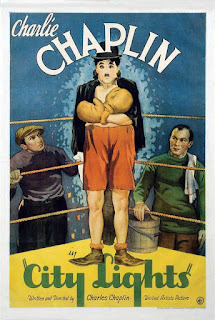
(January 1931, U.S.)
When you take into consideration that what makes me laugh most in the movies is DIALOGUE, then the concept of any silent film making me laugh seems impossible. Charlie Chaplin's legacy in film cannot be ignored, but I'd be lying if I told you that the guy cracked me up. Despite his extensive career, I only own three of his films. For me, CITY LIGHTS is not so much finding slapstick moments to laugh at, but rather an appreciation for the film making and drama behind its story.
Although "talking" pictures were on the rise since 1928, CITY LIGHTS was immediately popular with audiences. Today it's thought of as one of the highest accomplishments of Chaplin's prolific career. Although classified as a comedy, the film has an ending widely regarded as one of the most moving in cinema history, but I'll get into that later. Chaplin plays "the Tramp" who wanders the city and has his life changed not only by a beautiful, poor blind girl who sells flowers on the street but also an eccentric, suicidal millionare who befriends him after he (the Tramp) saves his life. Trouble is, this millionare can only remember and acknowledge the friendship whenever he's drunk. When he's sober, he has no memory of who the Tramp is and repeatedly throws him out of his house. Getting back to the girl, the Tramp not only falls in love with her but is determined to help her financially in order for her to have an operation that could restore her sight. The blind girl is under the impression that the Tramp is a millionare due to misunderstanding circumstances.
There is a boxing sequence I should mention. Not because it's particularly funny, but because Chaplin films it with a unique choreography that depicts the fight more like a group dance rather than a sporting match. Watch the fight carefully and you can see how the precise timing and detail of it all pays off as an admirable piece of film making. But I suppose back in that day of the Great Depression, it would have been considered very funny by audiences looking to escape their hard troubles.
Let me now discuss the final scene that I briefly mentioned before...the Tramp has been released from jail after ultimately stealing the money needed for the blind girl's operation. Having returned to the city streets, destitude, he wanders them again, only this time to discover the girl can only see but also has the financial means to own her own flower shop. She meets him, taking him for just another street tramp, having absolutely no clue who he really is (to her). She offers him one of her flowers and a coin. The Tramp begins to leave, then reaches for the flower. The girl takes hold of his hand to place the coin in it and, feeling him, she realizes who he really is. Look carefully how he places his hand at his face and concentrate on his eyes...

If ever there was a picture that said a thousand words, it's the sincere hope in his face that the girl will realize who he is is that's absolutely breathtaking. When she does understand and finally "sees", she smiles at the Tramp, the Tramp smiles back at her and you can't help but smile also. That kind of drama (even without the use of much dialogue), more than silly laughter, is what makes CITY LIGHTS a worthwhile film, in my opinion.
Favorite line or dialogue:
Girl (having just realized who her savior really is): "You?"
The Tramp: "You can see now?"
Girl: "Yes, I can see now."


No comments:
Post a Comment